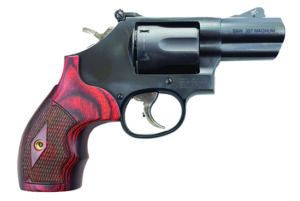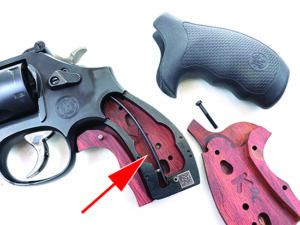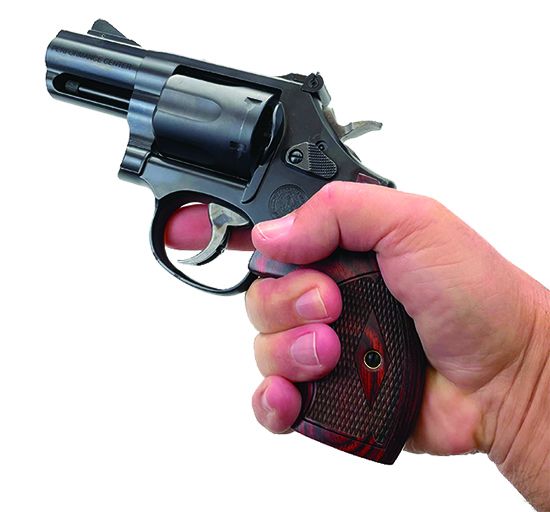You would be hard pressed to find something more effective in a defensive situation than a 357 Magnum revolver. The cartridge provides more velocity and energy than the more popular 9mm Luger round. The 9mm and 357 Magnum both use similarly-sized bullets, but because the 357 Magnum case is longer, it can hold more powder, which translates to about 30 percent more velocity, and depending on the load, about 70 percent more energy. Certainly, the 357 is ballistically superior to the 9mm, but that magnum power comes at a cost, and that is recoil, as we found out in a recent test of 357 Magnums sized for everyday carry (EDC). We had four guns, three from Smith & Wesson and one from Rossi, the RP63 with a 3-inch barrel. The S&W contenders included the Model 360 PD 163064 with a 1.88-inch barrel and two Performance Center guns, a Model 19 Carry Comp 13323 with a 2.5-inch barrel and a Model 60 Pro Series 178013 with a 3-inch barrel. All of these revolvers are built on either a small- or medium-size frame, are chambered in 357 Magnum, have exposed hammers, have double-action and single-action triggers, and have abbreviated barrels ideal for concealed carry.
How We Tested
Before going the range, we checked the cylinder-to-frame headspace with a feeler gauge and a range-rod match kit ($130; Brownells.com) to check barrel and chamber alignment. All chambers and bores aligned. Check. Typically, the space from the forcing cone to the front of the cylinder should be from 0.004 to 0.010 inches. All measured 0.008 inches except for the Model 19, which was tighter at 0.006 inches. Check. The bigger this gap, the more lead splash can be expected when shooting. We did not experience lead gap splash with the revolvers.
For accuracy testing, we fired the revolvers in single action using a rest. Targets were set at 15 yards. For speed shooting, we used NRA D-1 tombstone targets at 7 yards, firing a fully loaded cylinder as fast as possible in double action while trying to keep hits in center mass.
We fired both 38 Special and 357 Magnum ammo. The Aguila 357 Magnum ammo had 158-grain semi-jacketed soft-point (SJSP) bullets. The Blazer 38 Special +P loaded a 125-grain jacketed hollow point, and the Speer Gold Dot 38 Special had 125-grain Gold Dot hollow points. All of these rounds are good choices for self defense. Different calibers and loads were also loaded into the revolvers so we didn’t know what to expect. Recoil ranged from stout with the 357 Mag ammo to mild with 38 Specials. If our high school physics teacher had used a lightweight 357 Magnum revolver to demonstrate Newton’s Third Law, which states that for every action (force) in nature, there is an equal and opposite reaction, we would have paid better attention.
The top line is that all of these 357s are suitable for self defense, but some are better than others. As you know, there are always some “buts” in every review, so we get into the very fun weeds below.
Smith & Wesson Performance Center Model 19 Carry Comp 13323 357 Magnum
$1200
Gun Tests grade: A-
The Model 19 is set up for conceal carry. Even though it is heavier, the revolver is easy to shoot well, and the port helps tame powerful 357 Magnum ammo. Accuracy was good. The trigger could have been better.

| Action | Revolver, double action, single action |
| Overall Length | 7.5 in. |
| Barrel | 2.5 in. long, 1:16.5 in. twist |
| Overall Height | 5.0 in. |
| Maximum Width | 1.45 in. |
| Weight Unloaded | 33.0 oz. |
| Weight Loaded | 35.4 oz. |
| Cylinder Gap | 0.006 in. |
| Capacity | 6 |
| Frame | K-Frame, carbon steel |
| Barrel | Matte-black carbon steel |
| Cylinder | Matte-black carbon steel |
| Frame Front Strap Height | 2.1 in. |
| Frame Back Strap Height | 3.8 in. |
| Grip | 2 sets, checkered walnut and textured rubber |
| Grip Thickness Maximum | 1.1 in. |
| Grip Circumference Maximum | 5.2 in. |
| Front Sight | Trijicon night sight, serrated ramp, pinned |
| Rear Sight | Adj. notch |
| Sight Radius | 4.0 in. |
| Trigger Pull Weight Double Action | 11.0 lbs. |
| Trigger Pull Weight Single Action | 6.3 lbs. |
| Trigger Span Double Action | 3.3 in. |
| Trigger Span Single Action | 2.9 in. |
| Safety | Internal rebound, hammer block |
| Warranty | 1 year |
| Telephone | (800) 331-0852 |
| Website | Smith-Wesson.com |
| Made In | U.S. |
The Smith & Wesson Model 19 debuted in 1957 as a medium-sized K-frame double-action six-shot revolver engineered to accommodate the 357 Magnum cartridge. A generation ago, it was a very popular wheelgun and standard issue to many law-enforcement agencies across the U.S. The edge the K-frame has is that it is smaller and lighter than S&W’s N-frame revolvers chambered in 357 Magnum. Since 2019, S&W’s Performance Center has been building the Model 19 Carry Comp that is specifically tweaked for EDC. The lock-up design in newer Model 19s features a ball detent in the crane for a tighter and more secure closure. There was no wiggle in the cylinder. The gun used in this test sports a 2.5-inch barrel, and there is a 3-inch-barrel variant, too. The gaping port on the top of the barrel between the front sight and the muzzle is what you notice first, hence the name Carry Comp. S&W calls the slot in the barrel a PowerPort. Its job is to vent gas upward to help keep the muzzle flat for better recoil management. The cylinder is beveled, and all the edges are smooth, not sharp, for easier re-holstering. The finish is a matte blue, and the trigger and hammer are case colored. It is a sharp-looking gun. Other features include a Trijicon tritium front night sight, fully adjustable notch rear sight, trigger overtravel stop, and a tuned action. It also comes with two sets of grips, checkered wood and synthetic.
The port at the muzzle reduces the sight radius, but that’s a good trade-off for better recoil control. The port does work like magic. We appreciated that the ejector rod is full length to more easily shuck empties. The shooter-facing edge of the rear sight is serrated as is the front-sight ramp, the face of which is also serrated to reduce glare. The tritium tube embedded into the front sight glows, so acquiring the front sight is fast. With all those features, the Model 19 is nicely set up for EDC.

We fired the gun using the smaller checkered wood grips, which bear a resemblance to Eagle Grip Secret Service grips. There is one finger groove, and the area behind the trigger is filled so your knuckles don’t get beat up during recoil. The grip has a slight palm swell that fills your hand. We liked this grip. The left side is scooped out for HKS- and Pachmayr-style speed loaders. Large-handed users will need to curl their small finger under the butt. The wood grip is better for concealed carry, but it is not as comfortable as the rubber grip.
The action is slicked up, and we thought the double-action trigger pull was a lot less than the 11 pounds it measured. In single action, it measured a heavy 6.3 pounds. The overtravel stop on the rear of the trigger was helpful in fast double-action shooting because it ends the double-action trigger pull, and the shooter can go on to the next shot. The Model 19 used a flat main spring instead of a coiled main spring, so there is no stacking when the trigger is pressed in double-action mode. The tapered hammer spur has a small footprint but offers no-slip cocking. We liked the sights, and the PowerPort did what it was designed to do.
Throwing rounds down range, we saw the 19’s accuracy was good, even with the heavy single-action trigger pull. The Model 19 came in second place in overall accuracy with an average group size across all ammo that measured 1.79 inches. The Blazer 38 Special +P ammo using a 125-grain JHP bullet had a best group that measured 0.98 inches, which was the smallest group of all the revolvers tested. The Aguila 357 Magnum ammo averaged 2.02 inches, and the Speer Gold Dot 38 Special averaged 2.09 inches. That’s nice accuracy out of a 2.5-inch barrel at 15 yards and more than accurate enough for defensive work.
The Model 19 shot circles around the other revolvers on the combat range due to its mass of 35.4 ounces loaded and the compensator. Keeping the 19 on target in rapid fire was a piece of cake, and recoil was very tolerable, even with the hot Aguila 357 Magnum rounds. The grip enables a high hold for better control.
Our Team Said: The Model 19 is purpose-built for EDC and nearly won here, but the trigger is too heavy in double-action mode, we believe. On the plus side, the trigger was very smooth. The ported barrel helps in taming muzzle flip when shooting fast, and the wood grip was good for concealed carry and shooting. We liked the six-round capacity. All in, though, we expected a bit better from the Performance Center shop.
| 357 MAGNUM AND 38 SPECIAL RANGE DATA | ||||
| Aguila 357 Magnum 158-grain SJSP | Rossi RP63 | S&W Model 19 Carry Comp | S&W PC Pro Series Model 60 | S&W Model 360 PD |
| Average Velocity | 1115 fps | 1074 fps | 1110 fps | 1009 fps |
| Muzzle Energy | 436 ft.-lbs. | 405 ft.-lbs. | 432 ft.-lbs. | 357 ft.-lbs. |
| Smallest Group | 1.37 in. | 1.66 in. | 1.67 in. | 2.16 in. |
| Average Group | 1.98 in. | 2.02 in. | 2.10 in. | 3.23 in. |
| Blaser 38 Sp. +P 125-grain JHP | Rossi RP63 | S&W Model 19 Carry Comp | S&W PC Pro Series Model 60 | S&W Model 360 PD |
| Average Velocity | 990 fps | 862 fps | 980 fps | 830 fps |
| Muzzle Energy | 272 ft.-lbs. | 206 ft.-lbs. | 267 ft.-lbs. | 191 ft.-lbs. |
| Smallest Group | 1.24 in. | 0.98 in. | 1.01 in. | 1.66 in. |
| Average Group | 1.74 in. | 1.27 in. | 2.25 in. | 2.87 in. |
| Speer Gold Dot 38 Sp. 125-grain GDHP | Rossi RP63 | S&W Model 19 Carry Comp | S&W PC Pro Series Model 60 | S&W Model 360 PD |
| Average Velocity | 815 fps | 782 fps | 807 fps | 744 fps |
| Muzzle Energy | 184 ft.-lbs. | 170 ft.-lbs. | 181 ft.-lbs. | 154 ft.-lbs. |
| Smallest Group | 0.99 in. | 1.81 in. | 1.79 in. | 2.06 in. |
| Average Group | 1.38 in. | 2.02 in. | 2.58 in. | 2.09 in. |
To collect accuracy data, we fired five-shot groups from a bench using a rest. Distance: 15 yards with open sights. We recorded velocities using a ProChrono DLX digital chronograph set 10 feet from the muzzle. SJSP = semi-jacketed soft point. JHP = jacketed hollow point. GDHP = Gold Dot hollow point.
Written and photographed by Robert Sadowski, using evaluations from Gun Tests Team members. GT

























